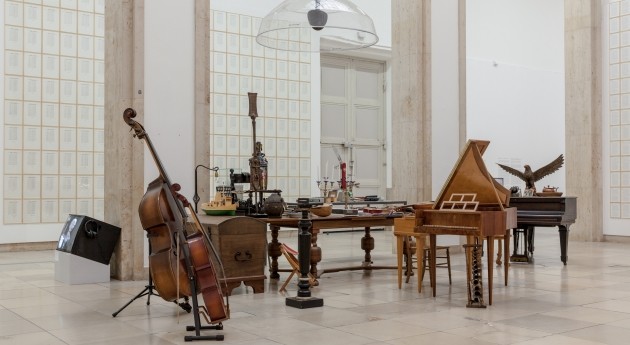Hanne Darboven
18 Sep 2015 - 14 Feb 2016

Hanne Darboven
Music Room, in the background Contrabass Solo, Opus 45, 1998-2000
Installation view, Haus der Kunst, 2015, photo Maximilian Geuter © Hanne Darboven Stiftung, Hamburg / VG Bild-Kunst, Bonn 2015
Music Room, in the background Contrabass Solo, Opus 45, 1998-2000
Installation view, Haus der Kunst, 2015, photo Maximilian Geuter © Hanne Darboven Stiftung, Hamburg / VG Bild-Kunst, Bonn 2015
HANNE DARBOVEN
Enlightenment
18 September 2015 – 14 February 2016
Hanne Darboven (1941–2009) is one of the twentieth century's most extraordinary international artists. The first major retrospective after the artist's death brings together key works from all phases of her prolific work. It is collaboratively organized by and simultaneously presented at the Bundeskunsthalle in Bonn and Haus der Kunst in Munich. While both exhibition venues highlight the outstanding and expansive oeuvre of this key conceptual artist in its entire temporal and stylistic breadth, each offers a different focal point within it. While the Bundeskunsthalle features works in which the artist is concerned with history, political events, and German history, the exhibition in Haus der Kunst concentrates on the expansive work series from cultural history, music, literature, and (natural) science. Here, we can see Darboven's special proximity to the thoughts of Enlightenment in terms of both the works' subject matter and the artist's individual mindset and political conviction.
At the center of the Munich exhibition are two principal installations: The first focusses on Darboven's books and publications, evoking in the viewer a sense of standing in a grand library at the heart of an Enlightenment institution; the second installation is a presentation of the original "music room" of Darboven's studio in Hamburg, offering access to Darboven's intellectual cosmos for the first time through this quasi-encyclopaedic archive of things. Her own collecting practice and taxonomic strategies have so far been mostly unrecognized by the public, but the resulting assemblages of objects offer fascinating insight into her work and personality.
Both exhibitions feature Darboven's characteristic series of symbols and writing; early Minimalist works that consist of both material pictures and construction drawings, her own musical compositions, including live performances, that implement numerical systems in sequences of notes, as well as filmic works. Further highlights will be the presentation of expansive key works like "Cultural History, 1880–1983" and "Schreibzeit". Also on view are sculptures and object-artistic pieces.
Enlightenment
18 September 2015 – 14 February 2016
Hanne Darboven (1941–2009) is one of the twentieth century's most extraordinary international artists. The first major retrospective after the artist's death brings together key works from all phases of her prolific work. It is collaboratively organized by and simultaneously presented at the Bundeskunsthalle in Bonn and Haus der Kunst in Munich. While both exhibition venues highlight the outstanding and expansive oeuvre of this key conceptual artist in its entire temporal and stylistic breadth, each offers a different focal point within it. While the Bundeskunsthalle features works in which the artist is concerned with history, political events, and German history, the exhibition in Haus der Kunst concentrates on the expansive work series from cultural history, music, literature, and (natural) science. Here, we can see Darboven's special proximity to the thoughts of Enlightenment in terms of both the works' subject matter and the artist's individual mindset and political conviction.
At the center of the Munich exhibition are two principal installations: The first focusses on Darboven's books and publications, evoking in the viewer a sense of standing in a grand library at the heart of an Enlightenment institution; the second installation is a presentation of the original "music room" of Darboven's studio in Hamburg, offering access to Darboven's intellectual cosmos for the first time through this quasi-encyclopaedic archive of things. Her own collecting practice and taxonomic strategies have so far been mostly unrecognized by the public, but the resulting assemblages of objects offer fascinating insight into her work and personality.
Both exhibitions feature Darboven's characteristic series of symbols and writing; early Minimalist works that consist of both material pictures and construction drawings, her own musical compositions, including live performances, that implement numerical systems in sequences of notes, as well as filmic works. Further highlights will be the presentation of expansive key works like "Cultural History, 1880–1983" and "Schreibzeit". Also on view are sculptures and object-artistic pieces.
